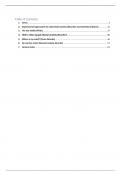Table of Contents
1. Stress .................................................................................................................................... 3
2. Experimental approaches to understand anxiety (disorders and attentional biases) .............. 15
3. The war within (PTSD) .......................................................................................................... 27
4. Hell is other people (Social anxiety disorder) ..................................................................36
5. Where is my mind? (Panic disorder) ..................................................................................... 46
6. No worries mate! (General anxiety disorder) ....................................................................... 51
7. Lecture notes ...................................................................................................................... 61
,Problem 1 – Stress
Stress
• External demands placed on an organism
• Organism’s internal biological and psychological responses to such demands
• Stress is the circumstance in which transactions lead a person to perceive a discrepancy
between the physical or psychological demands of a situation and the resources of his or her
biological, psychological, or social systems
Components of stress:
Resources → Stress taxes the person’s biopsychosocial resources for coping with difficult events or
circumstances
Demands → the amount of our resources the stressor appears to require
Discrepancy → poor fit, or a mismatch, between the demands of the situation and the resources of the
person
Transactions → In our transactions with the environment, we assess demands, resources, and
discrepancies between them
➔ Demand, resource, or discrepancy may be either real or just believed to exist
➔ Stress often results from inaccurate perceptions of discrepancies between environmental
demands and the actual resources
Cognitive appraisal
• Mental process by which people assess
1. whether a demand threatens their physical or psychological well-being and (primary)
2. the resources available for meeting the demand (secondary)
Primary appraisal – assessing meaning of the situation for our wellbeing, it can be
, • Irrelevant → similar symptoms were not followed by something negative
• Good → might suit our current situation (I want to skip an exam so feeling sick is good)
• Stressful → judged as feared (e.g. serious illness)
1. Harm-loss → amount of damage that has already occurred (e.g. in pain after injury and
thinking of it as a disaster, increasing stress further)
2. Threat → expectation of future harm (e.g. hospital patient contemplating hospital bills
and inability to work causes more stress)
3. Challenge → opportunity to achieve growth, mastery or profit (e.g. being offered a
higher position that requires more stress and responsibility but also better pay and
expanding skills)
• Appraisals can influence stress even when the stressor does not relate to us directly = vicarious
• Stress reaction depends on the type of primary appraisal
Secondary appraisal - assessment of the resources we have available for coping and whether they are
sufficient to meet the harm, threat or challenge we face
• E.g. “I can’t do it—I know I’ll fail.”; “I’ll try, but my chances are slim.”; “I can do it if Ginny will
help.” ; “If this method fails, I can try a few others.” ; “I can do it if I work hard.” ; “No
problem—I can do it.”
• When we judge our resources as sufficient to meet the demands, we may experience little or no
stress
Characteristics of Stressful Situations
• Life transitions → e.g. from high school to university, first time parenthood
• Difficult timing → e.g. pregnant at 15
• Ambiguity → lack of clarity in a situation
• Low desirability → circumstances that are undesirable to most people in virtually all respects
• Low controllability → Circumstances that seem to be outside the person’s behavioral or
cognitive influence
• Amount of stress increases with stressor frequency, intensity, and duration
Biopsychosocial Aspects of Stress
Biological aspects
• body is aroused and motivated to defend itself, and the sympathetic nervous system and the
endocrine system cause this arousal to happen
• Reactivity: physiological portion of the response to a stressor (measure by comparison against a
baseline, or ‘‘resting,’’ level of arousal)
o Influenced by: genetic factors, whether a person is under chronic stress (heightened
reactivity and arousal takes more time to return to baseline)
• Fight-or-flight: prepares the organism to attack the threat or to flee
o stimulate many organs, such as the heart, directly, and stimulates the adrenal glands of
the endocrine system, which secrete epinephrine, arousing the body still further
o adaptive in short-term but harmful to health if it is prolonged
, General Adaptation Syndrome Selye (1956)
Fight-or-flight response is only the first in a series of reactions the body makes
when stress is long-lasting. The series of physiological reactions = general
adaptation syndrome (GAS)
1. Alarm reaction: like fight-or-flight → functions to mobilize the body’s
resources
a. fast-acting arousal results from the (SAM) system =
Sympathetico-adrenomedullary
b. activates many organs through direct nerve connections,
including the adrenal glands which when stimulated release
epinephrine and norepinephrine into the bloodstream,
producing further activation
c. Less quickly, the HPA axis – hypothalamus-pituitary-adrenal axis
is activated where
i. the hypothalamus triggers the pituitary gland to secrete
ACTH
ii. which causes the adrenal gland to release cortisol into the bloodstream further
enhancing the body’s mobilization
2. Stage of resistance: if a stressor continues, physiological reaction enters the resistance stage
a. Sympathetic nervous system becomes less pronounced
b. HPA activation predominates
c. Body tries to adapt to the stressor
d. Physiological arousal remains higher than normal, but the organism may show few
outward signs of stress
e. The ability to resist new stressors may become impaired → more vulnerable to health
problems = diseases of adaptation (ulcers, high blood pressure, asthma)
3. Stage of exhaustion: prolonged physiological arousal produced by severe long-term or repeated
stress
a. Weaken the immune system and deplete the body’s energy reserves until resistance is
very limited
b. If the stress continues, disease and damage to internal organs are likely, and death may
occur
Allostatic load: effects of the body’s having to adapt repeatedly to stressors that accumulate over time
→ which creates wear and tear on the body and impairs its ability to adapt to future stressors





